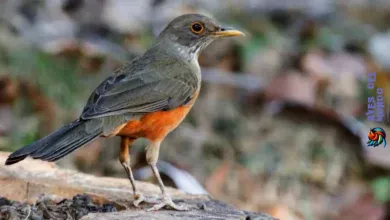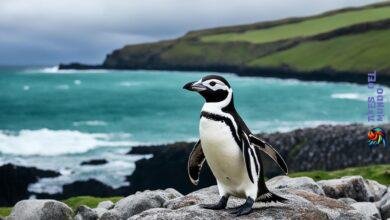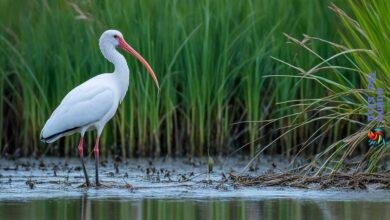Did you know that the Sea Eagle, also known as the White-Tailed Eagle, is Scotland’s largest bird of prey and the fourth largest eagle species in the world? With a wingspan of up to 8 feet and a population of over 200 adult birds, spotting these majestic creatures is a truly awe-inspiring experience.
Whether you are a wildlife enthusiast, a nature lover, or simply curious about these magnificent birds, this guide will provide you with valuable insights into the habitat, adaptations, behavior, and conservation status of Sea Eagles. Additionally, we will share expert tips on how to spot Sea Eagles in Scotland and support their conservation efforts.
So, prepare to be captivated by the beauty and grace of the Sea Eagle as we embark on an unforgettable journey to discover these remarkable creatures and learn why their conservation is of utmost importance.

Habitat and Adaptations of Sea Eagles
Sea Eagles, also known as White-Tailed Eagles, are predominantly found in the beautiful coastal areas and near lochs of Scotland. These magnificent birds thrive in habitats that provide them with ample access to water, allowing them to hunt for food with ease.
Sea Eagles have evolved various adaptations to survive and excel in their environment. Their large body size, broad wingspan, and powerful beaks and talons are distinct features that enable them to thrive in their habitat. With wings designed for soaring, Sea Eagles can effortlessly cover long distances while hunting for their prey.
One of the remarkable adaptations of Sea Eagles is their exceptional eyesight. These birds possess keen vision, allowing them to spot prey from great distances. Their sharp eyes enable them to precisely target and capture their preferred food sources.

Sea Eagles are true masters of the sky, utilizing their adaptations to navigate and survive in their coastal and loch habitats, making them a captivating species to observe.
Sea Eagle Species and Conservation Status
The Sea Eagle, or White-Tailed Eagle, is a species commonly found in Scotland. It is the largest bird of prey in Britain and is protected under the law. The conservation status of the Sea Eagle is currently classified as «least concern» according to the International Union for Conservation of Nature (IUCN). This is due to successful reintroduction efforts and an increasing population of over 200 adult birds. However, continued conservation efforts are crucial to maintain and protect this species for future generations.

| Sea Eagle Species | Conservation Status |
|---|---|
| Sea Eagle (White-Tailed Eagle) | Least Concern |
Predators and Threats to Sea Eagles
Sea Eagles, being one of the largest birds of prey, have few natural predators. However, they may occasionally encounter competition and aggression from other birds, such as Ravens, while in flight. These interactions can be intense as both species strive to establish dominance in the sky.
Of greater concern, however, are the human-induced threats that jeopardize the survival of Sea Eagles. These threats include habitat destruction, pollution, and illegal hunting. The loss of suitable nesting sites and feeding grounds due to urbanization and land development poses a significant risk to the species.
Moreover, pollution from chemical contaminants and marine litter can impact the Sea Eagles’ health and reproductive success. The accumulation of pollutants in their prey can affect their overall well-being and potentially disrupt their population dynamics.
Illegal hunting and persecution are additional threats that Sea Eagles face. Despite the legal protection afforded to these magnificent birds, poaching and deliberate harm still occur. The killing of Sea Eagles for various reasons, such as trophy hunting or the illegal trade of body parts, must be combated through stringent enforcement and public awareness initiatives.
Sea Eagles have few natural predators due to their impressive size and predatory abilities. However, it is the actions of humans that pose the greatest threat to their continued existence.
Conservation Efforts
To safeguard the Sea Eagle population and mitigate the risks they face, comprehensive conservation measures are essential. These efforts aim to protect the birds and their habitats, raise public awareness, and encourage responsible behavior towards these majestic creatures.
Conservation initiatives include:
- Habitat preservation and restoration projects
- Monitoring and research programs to track population trends
- Public education campaigns on the importance of Sea Eagle conservation
- Collaboration with local communities and stakeholders to promote sustainable land use practices
- Enforcement of strict laws and regulations against habitat destruction and illegal hunting
- Support for organizations dedicated to the protection and welfare of Sea Eagles
By implementing these measures, we can ensure the survival of Sea Eagles and maintain their vital role in the ecosystem. Together, we can protect these magnificent birds for future generations to admire and cherish.

Nesting Habits and Behavior of Sea Eagles
Sea Eagles, also known as White-Tailed Eagles, are magnificent birds that build large nests, called eyries, on cliffs or near lochs. These nests provide a safe and secluded environment for the breeding pair and their offspring. The sea eagle nesting habits are deeply rooted in selecting locations that offer protection and easy access to food sources. This careful selection ensures the survival and successful rearing of their young.
Sea Eagles display remarkable behavior when it comes to their nesting habits. They reuse their nests year after year, with both parents contributing to maintaining and even adding to the nest structure. This cooperative effort showcases their dedication and commitment to their offspring.
Sea Eagles are monogamous, meaning they form long-term pair bonds. This commitment is reflected in their shared responsibilities in raising their chicks. Both males and females actively participate in incubating the eggs, guarding the nest from intruders, and providing food for the young. This cooperative parenting strategy contributes to the survival and growth of the sea eagle population.
Another fascinating behavior of sea eagles is their territorial nature. They fiercely defend their nesting sites from intruders, sending a clear message that they will protect their young at all costs. Their courtship displays during the breeding season further highlight their territorial behavior, as they engage in majestic flight performances and vocalizations to attract mates and establish their dominance.
The nesting habits and behavior of sea eagles exemplify their remarkable adaptability and dedication to ensuring the survival of their species. By understanding and appreciating these behaviors, we can deepen our admiration for these magnificent birds and contribute to their conservation efforts.
Detailed Sea Eagle Nesting Behavior
| Nesting Behavior | Description |
|---|---|
| Nest Selection | Sea eagles choose secluded locations on cliffs or near lochs for their nests, providing protection and easy access to food sources. |
| Nest Reuse | Sea eagles reuse their nests year after year and continually maintain and add to the nest structure. |
| Cooperative Parenting | Both male and female sea eagles actively participate in incubating the eggs, guarding the nest, and providing food for the young. |
| Territorial Behavior | Sea eagles fiercely defend their nesting sites from intruders and engage in courtship displays during the breeding season. |

Through their nesting habits and behavior, sea eagles exemplify the beauty and complexity of nature’s intricate web. By respecting and conserving their habitats, we can continue to witness the awe-inspiring sight of these majestic birds in our skies.
Tips for Spotting Sea Eagles in Scotland
If you’re eager to catch a glimpse of the majestic Sea Eagles in Scotland, here are some tips to enhance your chances of spotting these incredible birds in their natural habitat.
1. Visit Reliable Areas
To increase your chances of sea eagle sightings, head to well-known areas where these birds are frequently spotted. Mull, Wester Ross, Fife, and Angus are renowned for their sea eagle populations. These locations offer ideal habitats and reliable opportunities for observation.
2. Mull’s Sea Eagle Hide
Mull, in particular, is a prime destination for sea eagle spotting. The island provides a designated hide where you can get exclusive views of a sea eagle nest. It’s an incredible opportunity to witness these magnificent birds up close.
3. Take Boat Trips
Embark on boat trips along the Scottish coast or to nearby islands, such as the Isle of Canna, to maximize your chances of spotting sea eagles. These trips offer unique perspectives and access to the birds’ preferred hunting grounds.
4. Be Patient and Observant
Spotting sea eagles requires patience and attentiveness. Find a comfortable spot, keep your eyes peeled, and maintain a respectful distance to avoid disturbing the birds. Take the time to enjoy the beautiful surroundings while keeping an eye out for these majestic creatures.

Sea Eagle Conservation and Wildlife Trips in Scotland
Scotland offers a range of wildlife trips and conservation initiatives dedicated to the sea eagle and other diverse Scottish wildlife. These experiences provide unique opportunities to observe these magnificent birds and other marine and terrestrial species, including seals, otters, dolphins, and whales. By participating in these wildlife adventures, not only do you create memorable experiences, but you also contribute to the conservation efforts aimed at protecting these species and their habitats.
Sea Eagle Conservation Initiatives
Various organizations and conservation groups in Scotland actively work towards sea eagle conservation. They conduct research, monitor populations, and implement habitat restoration projects to enhance the sea eagle’s survival and well-being. These initiatives aim to address threats such as habitat loss, pollution, and illegal activities that undermine the species’ conservation status.
«Conservation is a vital component of securing the future of the sea eagle population in Scotland. By collaborating with local communities, researchers, and conservationists, significant progress has been made in protecting these majestic birds and their habitats.» – Dr. Rachel Williams, Wildlife Conservation Society
Wildlife Trips in Scotland
Embark on guided wildlife trips in Scotland to witness the awe-inspiring beauty of the sea eagle and other fascinating creatures in their natural habitats. These trips are led by knowledgeable guides who provide valuable insights into the behavior, ecology, and conservation efforts concerning the wildlife. From scenic boat tours along the breathtaking coastline to hiking trails traversing diverse landscapes, each excursion offers a chance to spot sea eagles and encounter the rich biodiversity of Scotland’s wildlife.
Some popular locations for wildlife trips include:
- Mull: Home to an abundant sea eagle population and offering fantastic opportunities for sightings and photography.
- Wester Ross: Known for its dramatic coastal scenery and the chance to spot sea eagles and other marine wildlife.
- Fife and Angus: Explore the picturesque destinations and witness diverse birdlife, including sea eagles, along the coastal areas.
These wildlife trips not only provide unforgettable encounters with the wildlife but also generate awareness and financial support for ongoing conservation projects. By participating, you contribute to the sustainable conservation of Scotland’s precious natural heritage.
Sea Eagle Conservation Travel Tips
When planning your wildlife trip focused on sea eagle conservation in Scotland, consider the following tips:
- Choose reputable tour operators or guides who prioritize ethical wildlife viewing practices.
- Respect the animals’ space and keep a safe distance to avoid causing disturbance or stress.
- Follow responsible wildlife photography guidelines to minimize any negative impact on the animals and their habitats.
- Learn about the local conservation efforts and consider supporting them through donations or volunteering.
- Stay informed about current regulations and guidelines to ensure your activities align with the best practices for wildlife conservation.
By combining your love for wildlife with a commitment to responsible tourism, you can contribute to the ongoing conservation of sea eagles and their fragile ecosystems in Scotland.
| Benefits of Wildlife Trips in Scotland | Supporting Sea Eagle Conservation Efforts |
|---|---|
| Opportunities to observe and photograph sea eagles in their natural habitats | Funding research projects focused on sea eagle monitoring and conservation |
| Learning about the behavior, ecology, and conservation challenges facing sea eagles | Supporting habitat restoration initiatives to enhance the sea eagle’s environment |
| Contributing to local economies and sustainable tourism | Creating awareness and education about the importance of sea eagle conservation |

Other Wildlife to Spot in Scotland
Aside from the majestic Sea Eagles, Scotland is home to a diverse array of wildlife that will leave nature enthusiasts in awe. As you explore Skye and other parts of Scotland, keep your eyes peeled for sightings of Red Deer, Otters, Dolphins, Whales, Seals, Atlantic Salmon, Gannets, Golden Eagles, Puffins, Pine Martens, and the elusive Corncrake. These captivating species can be found in various habitats, including the enchanting coastal areas, meandering rivers, tranquil lochs, and majestic woodlands.
To increase your chances of spotting these incredible creatures, consider joining wildlife watching tours and boat trips. These ventures provide unparalleled opportunities to witness and appreciate Scotland’s natural wonders up close and personal. Imagine the thrill of observing playful otters frolicking in their habitats or catching a glimpse of dolphins gracefully leaping through the sparkling waters.
Whether you’re an avid birdwatcher scanning the skies for the magnificent Golden Eagle or a lover of marine life yearning to witness the grace of dolphins or the grandeur of whales, Scotland offers something truly special. Delve into the rich tapestry of wildlife that graces this beautiful land, and let the sights and sounds of nature ignite your passion for conservation and appreciation of our natural world.



